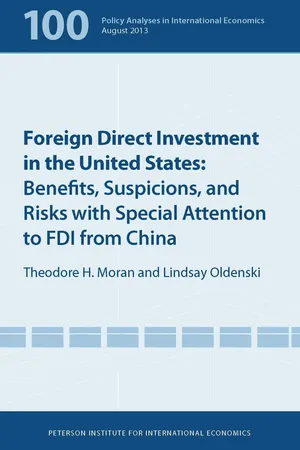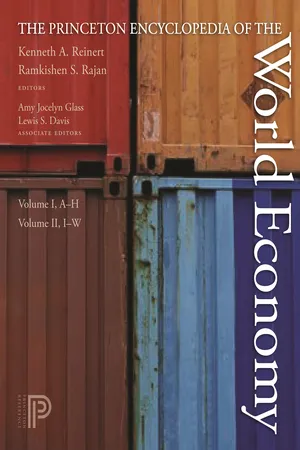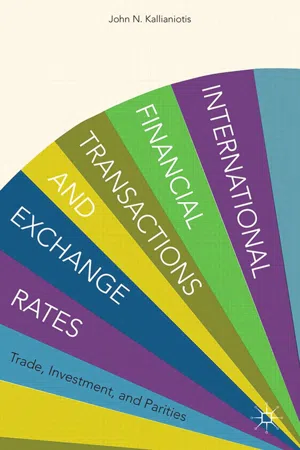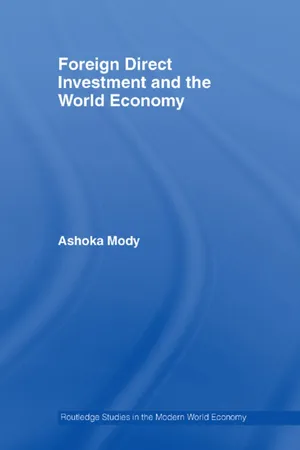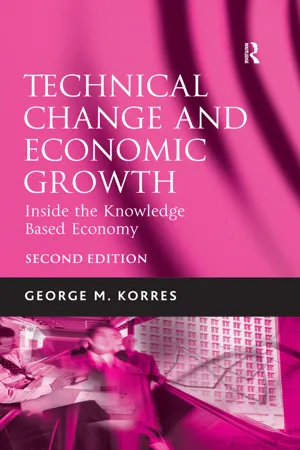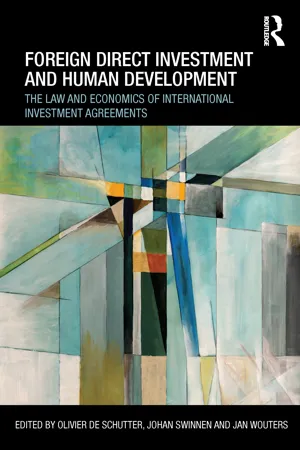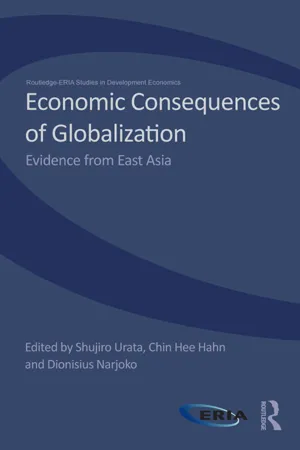Economics
Horizontal FDI
Horizontal FDI refers to foreign direct investment where a company invests in the same industry abroad as it operates in at home. The primary goal of horizontal FDI is to expand market presence, gain access to resources, or reduce production costs. This type of investment involves the replication of the firm's activities in a foreign location.
Written by Perlego with AI-assistance
Related key terms
Related key terms
1 of 4
Related key terms
1 of 3
10 Key excerpts on "Horizontal FDI"
- eBook - ePub
Foreign Direct Investment in the United States
Benefits, Suspicions, and Risks with Special Attention to FDI from China
- Edward Graham, Theodore Moran, Lindsay Oldenski, Paul Krugman(Authors)
- 2012(Publication Date)
More recently, a branch of international economics has emerged to formalize and add to the ideas of Hymer, Kindleberger, Vernon, Dunning, and Williamson with regard to manufacturing and services FDI. While most multinational manufacturing and services corporations engage in complex production strategies, the formal theoretical and empirical literature has often found it useful to break the main components down into separate categories depending on the primary motive for FDI. This allows for rigorous study of each channel, independent of complicating circumstances. The most common of these channels are known as vertical, horizontal, and export platform FDI. In practice, most firms engage in some combination of them, but considering them separately helps in understanding firms’ many different motives for investment.Vertical FDI focuses on how firms choose to source inputs and separate production activities across borders. In this case, the production process is fragmented into its various components, which can each take place in a different country. Generally, more complex and strategic aspects of production, such as management and product design, take place at the firm’s headquarters in this model while more routine tasks, such as production or assembly of inputs, occur at foreign affiliates (Oldenski 2012 ). Vertical FDI occurs most often when a firm’s headquarters country and affiliate country differ in their skill endowments and wages. A US automaker moving production and assembly of parts to Mexico to take advantage of abundant low-wage labor is a typical example, as FDI facilitates trade within the firm.Elhanan Helpman (1984) was one of the first economists to develop a model for vertical FDI. In his framework, firms can source inputs in any location to minimize costs. As a result, each stage of multinational production takes place where there is a comparative advantage in that production activity. Robert Feenstra and Gordon Hanson (1997) developed a similar model and found empirical support for it using data on US firms operating in Mexico. James Markusen (1997) - Kenneth A. Reinert, Ramkishen Rajan, Amy Joycelyn Glass, Lewis S. Davis, Kenneth A. Reinert, Ramkishen Rajan, Amy Joycelyn Glass, Lewis S. Davis, Kenneth Reinert, Ramkishen Rajan, Amy Glass, Lewis Davis(Authors)
- 2010(Publication Date)
- Princeton University Press(Publisher)
headquarter services . Although this is clearly a multidimensional factor, it is common to model it in terms of a single index of firm productivity. The most sophisticated treatment along these lines is found in work on heterogeneous firms by Helpman, Melitz, and Yeaple (2004), which combines the simplest version of the horizontal motive for FDI (to be discussed later in this article) with the assumption that firms differ in their productivities. A potential firm must pay a sunk cost to determine its productivity, and when this is revealed, active firms sort themselves into different modes of production. Low-productivity firms produce only for the home market; medium-productivity firms choose to pay the fixed costs of exporting; but only the most productive firms choose to pay the higher fixed costs of engaging in FDI. These predictions are consistent with the evidence. As a further contribution, the paper derives from the model the prediction that industries with greater firm heterogeneity will have relatively more firms engaged in FDI and shows that this prediction is confirmed by the data. This work and others like it do not explore, however, why firm productivities differ in the first place. Prior investment in research and development (both process and product) and in marketing presumably account for the disproportionately greater productivity of most MNEs.Location While international trade theory has tended to take ownership advantages for granted or else to model them in fairly obvious ways, rather more attention has been devoted to exploring alternative motives for MNEs to locate abroad. A key issue that has attracted much attention is the distinction between “horizontal” and “vertical” FDI. Horizontal FDI occurs when a firm locates a plant abroad in order to improve its market access to foreign consumers. In its purest form, this simply replicates its domestic production facilities at a foreign location. Vertical FDI, by contrast, is not primarily or even necessarily aimed at production for sale in the foreign market, but rather seeks to take advantage of lower production costs there. Since in almost all cases the parent firm retains its headquarters in the home country, and the firm-specific or ownership advantages can be seen as generating a flow of headquarter services to the host-country plant, there is a sense in which all FDI is vertical. Nevertheless, the distinction between market-access and cost motives for FDI is an important one.The horizontal motive for FDI reflects what Brainard (1997) has called a “proximity-concentration trade-off”: building a local plant saves on trade costs and so has the advantage of proximity; but it loses the benefits of concentrating production in the firm’s home plant. Let π *(t *) denote the operating profits that a potential MNE can earn from selling in a foreign market subject to per unit trade costs t * (which can include both tariffs and transportation costs). These operating profits are decreasing in t *: higher trade costs reduce operating profits. Constructing a local plant avoids the trade costs, leading to higher operating profits of π *(0); however, it requires an additional fixed cost f . Hence the trade-cost-jumping gain, the difference between the total profits from FDI, ΠF , and those from exporting, ΠX- eBook - ePub
International Financial Transactions and Exchange Rates
Trade, Investment, and Parities
- I. Kallianiotis(Author)
- 2013(Publication Date)
- Palgrave Macmillan(Publisher)
FDI is defined as the net inflows of investment (inflow minus outflow) to acquire a lasting management interest, which is 10 percent or more of voting stock, in an enterprise operating in an economy other than that of the investor. FDI is the sum of equity capital, other long-term capital, and short-term capital as shown in the balance of payments of a country. FDI usually involves participation in management and joint-venture, a business agreement in which parties agree to develop, for a finite time, a new entity and new assets by contributing equity. They exercise control over the enterprise and consequently share revenues, expenses and assets; there are other types of companies such as joint-venture limited by guarantee where joint ventures are limited by a guarantee with partners holding shares.FDI also includes transfer of technology, also known as technology transfer or technology commercialization, which is the process of transferring skills, knowledge, technologies, methods of manufacturing, samples of manufacturing, and facilities among governments or universities and other institutions to ensure that scientific and technological developments are accessible to a wider range of users, who can then further develop and exploit the technology into new products, processes, applications, materials, or services; this is closely related to knowledge transfer and expertise. There are two types of FDI: inward and outward. They result in a positive or negative net FDI inflow and “stock of foreign direct investment,” which is the cumulative number for a given period. FDI is one example of international factor movements. Direct investment excludes investment through purchase of shares.Theories on FDI focus on factors that affect investment decisions in different countries. MNCs invest abroad to satisfy their objective of profitability by using their competitive advantage of monopolistic power, which depends on their superior technology, advertising spending, and R&D investments. Foreign firms are attracted by many economic factors of the host country and not in particular by industry-specific factors. Such factors include per capital expenditures (i.e., spending) for products produced by industry j (e.g., telecommunications), efficient communications systems, costs of production in the host country, corporate tax rates for MNCs, and others, as Kim and Lyn (1987) have mentioned. - Bambang Susantono, Cyn-Young Park(Authors)
- 2020(Publication Date)
- Asian Development Bank(Publisher)
4Horizontal FDI theories assume similarity across countries in factor price differences. In contrast, theories that predict vertical expansion abroad (Helpman 1984, 1985) rely on differences in factor proportions across countries and on the assumption that headquarters and production activities have different factor intensities, in the spirit of the Heckscher–Ohlin models. The tests for horizontal versus vertical FDI motives are very limited because detailed data on the activities of multinationals’ affiliates is lacking. For instance, Carr, Markusen, and Maskus (2001) analyze the sensitivity of total US affiliate sales in the host market to a set of country variables that the theory predicts should have a bigger effect on one type of FDI than the other. Their results show that affiliate sales are larger in countries more similar to the US in size, but decrease as the cost of investing in the host country falls, and with the cost of importing back goods from the host country (increasing with the cost of exporting to the host country). They interpret these results as evidence of the prevalence of Horizontal FDI, but this is far from a conclusive test.In the vertical FDI side, the game-changing work by Antras (2003) introduced contract-theory considerations into the sourcing decisions of firms and incorporated features of the institutional environment. More precisely, firms in industries with more relation-specific investments, as defined by Nunn (2007), are more likely to keep the different stages of production within the boundaries of the firm. The interaction between industries with different contract intensity and countries with different institutional strengths (e.g., degree of contract enforcement) produces predictions about the location of “vertical” affiliates.5- eBook - ePub
- Sherif Seid(Author)
- 2018(Publication Date)
- Routledge(Publisher)
inter alia, the protection of domestic labour against the export of jobs abroad, adequate revenue from the repatriation of dividends earned by overseas subsidiaries of home-based parent companies, the promotion and protection of technological leads enjoyed by home based MNEs, access to raw materials in short supply in the home state, or the need for the equal and reciprocal treatment of inward and outward investment (Muchlinski, 1995: 103). With regard to host states, FDI that comes with new capital, technology, goods or services not normally found locally at equivalent or lower cost is generally encouraged. However, conditions may be imposed relating to level of investment and local ownership, performance requirements, import levels, technology and skills transfer, job levels, export levels or long-term investment strategy (Muchlinski, 1995: 104).Increasingly, the laws of host countries on FDI are taking the form of a code or a single piece of legislation that states the pertinent rules relating to FDI in the country.1 They specify the authority responsible for supervising investment, conditions of entry and the sectors open to FDI, the controls FDI is subjected to, remissibility of funds, performance requirements, incentives granted to investors, and the circumstances of the termination of foreign investment and other similar matters. Such codes typically apply to FDI alone, while foreign investors in other sectors must generally obey all relevant laws. The existence of a single code enables the foreign investor to acquaint itself with the laws on foreign investment of a country more easily. It is part of an attempt to communicate the certainty in the rule of law that was discussed as part of the arguments for “good governance” in state intervention discussed in the last Chapter.Many countries now have laws controlling FDI. Even countries which traditionally maintain an open policy towards FDI now impose restrictions on the flow and activities of FDI. Until recently, the US policy on FDI, for example, was driven by “the principle of neutrality”, that is, trying not to be biased either in favour of or against FDI (Graham and Krugman, 1991: 119). Accordingly, foreign firms had identical rights of establishment as domestic firms and, once established, foreign firms did not face greater burdens as a result of government action or policy than domestic firms, nor did they receive special privileges that domestic firms did not (national treatment) (Graham and Krugman, 1991: 120). There were, of course, some exceptions to the “principle of neutrality” which applied essentially to those industries subject to federal regulation (Graham and Krugman, 1991: 120).2 Since 1988, however, there has been a tendency to extend the Federal Government’s ability to restrict FDI in areas beyond the federally regulated industries. The Exon-Florio Amendment,3 - eBook - ePub
- Ashoka Mody(Author)
- 2007(Publication Date)
- Routledge(Publisher)
The answer to the question in this chapter’s title flips if integration is assessed in terms of income convergence. That promise of FDI is yet to be fulfilled. There is little evidence that FDI served to speed up convergence despite the important trends in its levels and composition. This was so for two reasons. First, FDI flows remained highly concentrated and second, the benefits from FDI appear to have accrued principally where conditions were already conducive to investment and growth. FDI can, at least temporarily, draw a country’s resources from domestic entrepreneurs who are unprepared to deal with the competition.The policy and regulatory agenda at the domestic and international levels has focused on the need to further reduce barriers to foreign investment without creating undesirable tax competition among nations. By necessity, progress has been incremental and, even if the current efforts are successful, there is no reason to believe that the role of FDI will change significantly. I suggest, somewhat speculatively, that FDI that is associated with greater labor mobility could prove to be more of an integrating force.This chapter is a selective survey of the literature, with an attempt to highlight results from recent and ongoing research. Inevitably, the selection of research reported is biased towards my own interests and analyses. The rest of this chapter is organized around three objectives: first, to provide an overview of the trends in the levels and composition of FDI flows; second, to consider the analytical basis for the high concentration of FDI and the mechanisms through which FDI has an impact on domestic economies; and third, to describe the policy and regulatory issues faced at the level of the host country and in bilateral, regional, and multilateral forums.The spread of FDI
Ostensibly, FDI has been an integrating force in several ways. The first, and most obvious, indicator is the rapid—indeed, explosive—growth in FDI. Figure 1.1 shows these global trends. From about $55 billion in the early 1980s, annual worldwide FDI rose to just over $200 billion in 1990 and then rose dramatically over six-fold to almost $1.4 trillion in 2000. While much of this increase represented a recirculation of capital within developed countries, developing countries also benefited from the huge expansion during this period. In the 1990s, FDI flows to developing countries rose from just under $40 billion in 1990 to over $240 billion in 2000, again a more than six-fold increase. - eBook - ePub
FDI, Regionalism, Government Policy and Endogenous Growth
A Comparative Study of the ASEAN-5 Economies, with Development Policy Implications for the Least Developed Countries
- Anthony Bende-Nabende(Author)
- 2018(Publication Date)
- Routledge(Publisher)
positive spillover effects of FDI. FDI can stimulate economic growth through the creation of dynamic comparative advantages that lead to new technology transfers, capital formation, human resources development (i.e. spillover effects on domestic suppliers, research institutes, employment and training of more skilled personnel, and the introduction of new managerial and organisational techniques) (Chudnovsky, 1993), and expanded international trade. Georgian and Weinhold (1992) have argued that FDI increases international integration and interdependence; facilitates the trade of goods, services and knowledge, and allows countries to specialise more effectively, thus increasing the benefits of comparative advantage based trade and economies of scale; and also increases productivity, widens the scope of competition, and spurs the economy of the host country.The experiences of the Asian NIEs which have achieved high rates of growth with a substantial amount of FDI, and sustained it for longer than the convergence growth theory could have projected, with substantial involvement of FDI, have raised an awareness of the link between FDI and economic growth. It is, therefore, not surprising that developing countries have changed attitude and shifted from controlling and containing FDI to encouraging it in order to reap its benefits. The growing importance and recognition of FDI is exemplified by the shift towards greater openness of national economies to inward FDI particularly in the LDCs where a growing number of countries have been seeking to attract FDI by liberalising laws and regulations towards TNC activities.In light of the link that has been identified between FDI and economic growth, the discussion that follows focuses on the positive effects of FDI on the economic growth of host developing countries. For the negative effects of FDI see for instance, Streeten (1974).FDI and Human Resources DevelopmentThere is an economic argument that more workers mean more output. Growth in output, however, depends on the quality and productivity of all inputs, i.e. physical capital, human capital, technology as well as number of workers. The growth in labour supply will only lead to economic growth in as far as it is productive, i.e. improved in quality/skill. - eBook - ePub
Technical Change and Economic Growth
Inside the Knowledge Based Economy
- George M. Korres(Author)
- 2016(Publication Date)
- Routledge(Publisher)
Direct investment is a category in which an international investment made by a resident entity in one economy (direct investor) with the objective of establishing a lasting interest in an enterprise (or, otherwise, the direct investment enterprise) resident in another economy is classified. Direct investment involves both the initial transaction between the entities and all subsequent capital transactions between them and among affiliated enterprises, both incorporated and unincorporated. OECD recommends that direct investment flows be defined as: “A foreign direct investor may be an individual, an incorporated or unincorporated public or private enterprise, a government, a group of related individuals, or a group of related incorporated and/or unincorporated enterprises which has a direct investment enterprise – that is, a subsidiary, associate or branch – operating in a country other than the country or countries of residence of the foreign direct investor or investors”. Moreover, following the IMF definition, we can say that: “Direct investment refers to investment that is made to acquire a stake in an enterprise operating in an economy other than that of the investor, the investor’s purpose being to have an effective voice in the management of the enterprise. The foreign entity or group of associate entities that makes the investment is termed the direct investor - eBook - ePub
Foreign Direct Investment and Human Development
The Law and Economics of International Investment Agreements
- Olivier De Schutter, Johan Swinnen, Jan Wouters(Authors)
- 2012(Publication Date)
- Routledge(Publisher)
167 Hence, our findings on indicators of economic development – economic growth, poverty and income inequality – in the previous sections do indicate that FDI may enhance human development when the conditions are right. In the remainder of this section we look into the impact of FDI on the non-economic components of human development. First, we discuss two opposing views on the relationship between FDI and human development. Then we look at the empirical evidence for some non-economic components of human development such as labour standards, education, the environment and gender issues. Finally, we expand on the effect of foreign investment on human rights in the host country.3.7.2 Race to the bottom or climb to the top?
With respect to the impact of FDI on human development there exist two basic hypotheses. The first, critical perspective states that FDI leads to a ‘race to the bottom’: foreign companies tend to locate production in countries or regions with low wages, low taxes and weak social and environmental regulations. In order not to lose investment and jobs, developing countries are thus forced to lower their standards, and corrupt governments are supported as long as they favour the company's objectives.168 Moreover, when FDI is motivated by the search for raw materials, the control of these resources might be better ensured when the company has close links with the (autocratic) host government.169 - eBook - ePub
Economic Consequences of Globalization
Evidence from East Asia
- Shujiro Urata, Chin Hee Hahn, Dionisius Narjoko(Authors)
- 2012(Publication Date)
- Routledge(Publisher)
8 Vertical and Horizontal FDI technology spillovers Evidence from Thai manufacturing Archanun Kohpaiboon 1 Introduction Enticing multinational enterprises (MNEs) to set up affiliations is high on the policy agenda in many countries, especially developing ones, as their entry would bring in much-needed capital, new production technologies, marketing techniques and management know-how. While all of these potential benefits of foreign direct investment (FDI) are viewed as important, particular emphasis is placed on technological gains in the productivity and competitiveness of the domestic industry, known as FDI technology spillovers (henceforth referred to as ‘FDI spillovers’). As a result, the expectation of gaining from technology spillover persuades many developing countries to offer various incentives in order to attract FDI. Nonetheless, only in some investment-receiving (host) countries are FDI spillovers empirically found. While tangible efforts have recently been made to gain a better understanding of the factors that determine the presence of FDI spillovers, they have not thus far borne fruit (Crespo and Fontoura 2007). The existing literature divides into two broad themes. First, Horizontal FDI spillovers are assumed not to be automatic but are hypothesized to be a function of the economic environment and domestic policies in host countries. In this literature, two determinants have been generally recognized as conditioning gains from FDI: the trade policy regime and the absorptive capability of locally owned enterprises. 2 While both of these factors are acknowledged, most researchers have examined only the role of absorptive capability. This may be because of the difficulty of finding a reliable proxy for protection across industries. So far only a few studies (e.g. Kokko, Zejan and Tansini 2001; Kohpaiboon 2006a) have empirically examined the role of the trade policy regime
Index pages curate the most relevant extracts from our library of academic textbooks. They’ve been created using an in-house natural language model (NLM), each adding context and meaning to key research topics.
Explore more topic indexes
Explore more topic indexes
1 of 6
Explore more topic indexes
1 of 4
